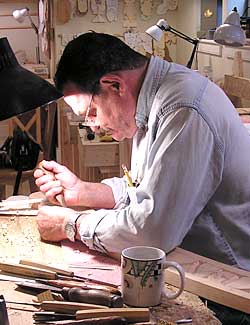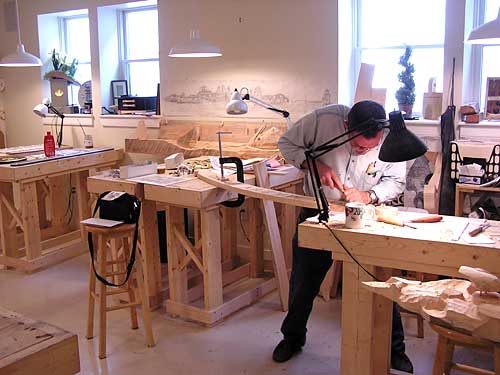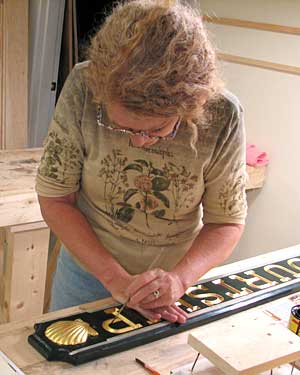Keeping the Craft Alive
by Suzanne Daub
 Tucked away on the lower level of #9 Wampanoag Way, Paul McCarthy and Jean Petty are keeping tradition alive. It is here that hundreds of quarterboards, dozens of signs, and carved mantles, whales, eagles, and other decorative pieces are drawn, carved, painted, and guilded. These are the beautiful carvings that adorn many island homes, inside and out. Downtown Nantucket is a portfolio of their work: signs for The Brotherhood of Thieves, Gypsy, the Atlantic Cafe, Nantucket Brand, the Nantucket Historical Association, Easy Street, In-Essentials, 2 Union Street, the Trading Post, are just a few examples of their work. The stunning “Going on the Whale” carving that hangs outside the Nantucket Whaling Museum is yet another of their pieces.
Tucked away on the lower level of #9 Wampanoag Way, Paul McCarthy and Jean Petty are keeping tradition alive. It is here that hundreds of quarterboards, dozens of signs, and carved mantles, whales, eagles, and other decorative pieces are drawn, carved, painted, and guilded. These are the beautiful carvings that adorn many island homes, inside and out. Downtown Nantucket is a portfolio of their work: signs for The Brotherhood of Thieves, Gypsy, the Atlantic Cafe, Nantucket Brand, the Nantucket Historical Association, Easy Street, In-Essentials, 2 Union Street, the Trading Post, are just a few examples of their work. The stunning “Going on the Whale” carving that hangs outside the Nantucket Whaling Museum is yet another of their pieces.
Part workshop, part classroom, part gallery, part shop, the rooms they occupy beneath Arrowhead Nursery’s new store is where McCarthy, Nantucket’s only master woodcarver, and folk artist Petty spend most of their time.
The scent of freshly cut wood permeates the space; classic rock plays softly in the background. There are nearly a dozen well-lit work benches, but it’s not hard to tell which is the master’s bench: it’s the one with a dozen or more carving tools (specially designed and made by McCarthy) that look too simple for the intricate work being done, quarterboards cut and ready to be carved lean against the wall behind, pen-and-ink drawings are pinned up everywhere, and a tall mug of coffee is kept handy. As he spoke, he carved.
McCarthy has been carving for 45 years. He got his start in high school shop class, but it was not until 1969, after a stint in the Air Force where he served in Korea, that he opened his business and started carving full time. “I’ve done it every day ever since,” he added.

McCarthy’s first shop was in Scituate, where he was born and raised. He was very active in community organizations, vice president of the Scituate Chamber of Commerce and a member of the Scituate Historical Society. Three-dimensional carving is characteristic of his work; most signs were flat and painted before McCarthy’s work became the standard. “The whole South Shore is full of Paul’s signs,” Jean Petty added. His is the work of a craftsman, beautifully made and very durable. For the U.S. Constitution Museum in Boston, McCarthy carved the biggest quarterboard ever: 36 feet long. “I did it in 1975, and it’s been there ever since.”
He has a deep respect for history and this shows in his work. “I’ve been interested all along in early Americana,” he commented. History is one of the aspects of Nantucket that he always liked. “It was right up my alley. We used to come and visit…bring the kids and rent bikes for the day…I always thought that it would be a good place to set up the business.” He even mentions Nantucket in his first book, Woodcarving Illustrated, published in 1983, in reference to the history of carved pineapples.
In addition to carving and writing, McCarthy also does illustrations, t-shirt designs, hand-drawn invitations, and logo designs. “Before you start to carve, you have to draw,” he explained. He often does preliminary sketches for customers as he takes their orders. He’s even won contests for his illustrations: locally, his drawings won four years in a row for the Boston Pops t-shirt. “They stopped doing the contest ‘cause I kept winning,” he joked. “I liked it because I got front row seats!”
Paul McCarthy finally got the chance to pursue his dream of carving on Nantucket in the early 1990s, when a former student and employee opened a shop here and called on him for help. “They made me an offer...” McCarthy laughed as he remembered, “I hadn’t worked a 40-hour week in years, so I took it.” He turned his shop on the Cape over to his son Michael, and came to Nantucket to work with Billy Rowe.
An aspect of Nantucket that he found interesting when he started carving on-island is that people here name their houses. The quarterboards he had made on the Cape and South Shore always carried the family name. “It makes more sense [naming the house]…throughout history, it was the name of the ship on the quarterboards, not the name of the ship owner,” commented McCarthy.
McCarthy worked on-island till Rowe closed his shop in 2002, and then moved back to Scituate. It was there that he reconnected with artist Jean Petty, whom he had known years earlier, when he stopped into a coffeeshop in Scituate on his way to do some smelt fishing. “It was my favorite coffeeshop,” Petty explained, “and I had just run in on my way to work...when I saw him, all I could say is ‘what are you doing here?’”
 Petty had grown up in a family of artists and started painting at the age of 12. Over the years, she pursued her artistic sensibilities in a variety of ways: with stained glass, candle art, ceramics, graphic design, as well as painting. When she and McCarthy rekindled their friendship, Petty was working as a senior graphic artist and color prepress specialist and feeling a bit burnt-out by the corporate world. “I had started painting again…painting relaxes me and it’s much more satisfying [than the computer work she was doing]—you can hold it and it lasts… and Paul said to me ‘you should be on Nantucket.’” She accompanied him to the island on one of his trips. Nantucket Looms took several of her first pieces, and she’s been selling her paintings here ever since.
Petty had grown up in a family of artists and started painting at the age of 12. Over the years, she pursued her artistic sensibilities in a variety of ways: with stained glass, candle art, ceramics, graphic design, as well as painting. When she and McCarthy rekindled their friendship, Petty was working as a senior graphic artist and color prepress specialist and feeling a bit burnt-out by the corporate world. “I had started painting again…painting relaxes me and it’s much more satisfying [than the computer work she was doing]—you can hold it and it lasts… and Paul said to me ‘you should be on Nantucket.’” She accompanied him to the island on one of his trips. Nantucket Looms took several of her first pieces, and she’s been selling her paintings here ever since.
Even after he returned to the Cape, McCarthy’s Nantucket customers found him. There were no woodcarvers left on Nantucket, and none as skilled as McCarthy on the Cape. “I kept a hefty connection with Nantucket and with the people here...I was coming back [to the island] every month…I still felt that Nantucket was the place to be.”
After a few years of dividing their time between Nantucket and the Cape, the two had an opportunity to establish a shop on the island. In the spring of 2006, they returned. Paul does the carving, and Jean does all of the painting: “She’s the folk artist around here,” McCarthy exclaimed. Petty does do some carving, “just some whales and mermaids…folk art…I got into carving because I like painting on wood. It’s hard to find anything of good quality anymore, so now I carve it then paint it,” she explained. Petty’s love of the history and lore of coastal communities is a strong theme through in her work.
A few months after they opened Nantucket Carving & Folk Art, McCarthy started offering classes again—he had taught on Nantucket a decade before—and some of his previous students signed up. “Some of them brought projects with them from class 10 years ago that they hadn’t finished yet!” he smiled. Classes are offered Wednesday evenings and Thursday afternoons off-season and on Saturdays year-round, and McCarthy’s students range in age and profession, but they all respect and adore him.
“He’s amazing,” said Kate O’Connor, one of the proprietors of the Atlantic Cafe, “He’s not only a great carver, but he’s an extraordinary teacher: he tells you everything and makes you feel successful. Paul is a wonderful guy—we’re lucky to have him on the island.”
William Tramposch, executive director of the Nantucket Historical Association and a student of McCarthy’s, agrees. “I enjoyed [class] a lot…one of the great attractions is that it is a craft he’s keeping alive, and he’s very happy to share his knowledge.”
Many of the 25 students now taking classes with McCarthy will be participating in Nantucket Carving & Folk Art’s first woodcarving exhibition this weekend, August 3 and 4, from 10 am to 4 pm at 9 Wampanoag Way. McCarthy and his students will demonstrate as well as exhibit their work, some of which will be for sale.